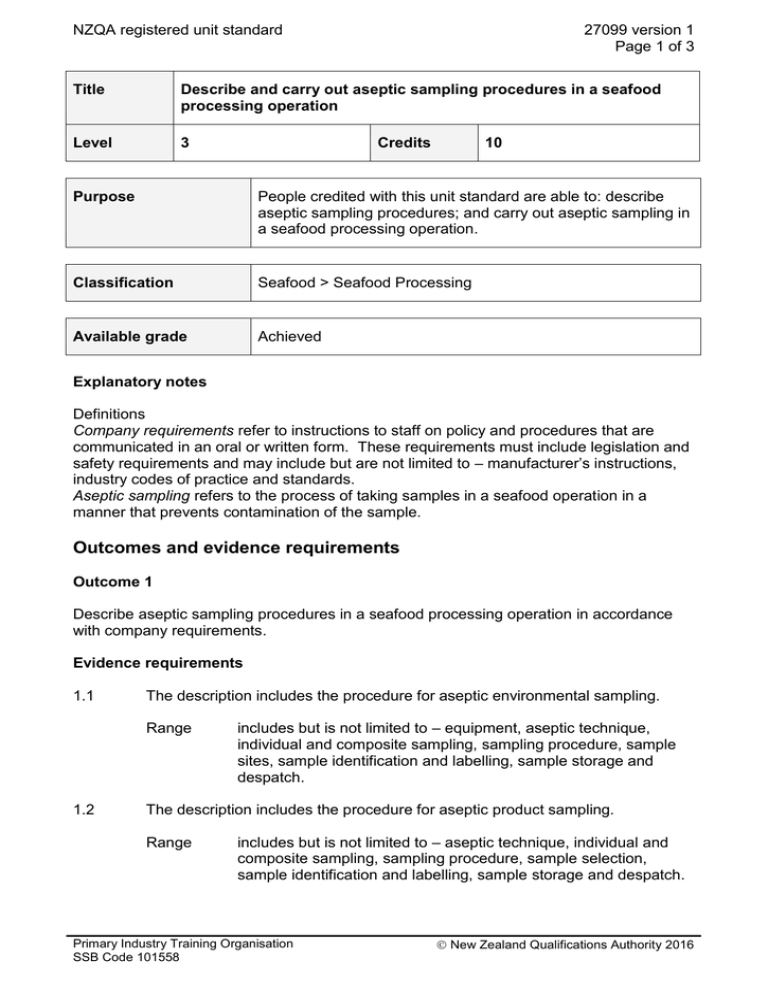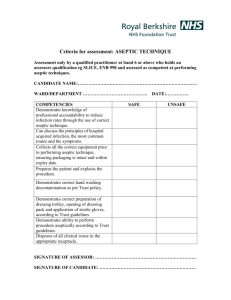NZQA registered unit standard 27099 version 1 Page 1 of 3
advertisement

NZQA registered unit standard 27099 version 1 Page 1 of 3 Title Describe and carry out aseptic sampling procedures in a seafood processing operation Level 3 Credits 10 Purpose People credited with this unit standard are able to: describe aseptic sampling procedures; and carry out aseptic sampling in a seafood processing operation. Classification Seafood > Seafood Processing Available grade Achieved Explanatory notes Definitions Company requirements refer to instructions to staff on policy and procedures that are communicated in an oral or written form. These requirements must include legislation and safety requirements and may include but are not limited to – manufacturer’s instructions, industry codes of practice and standards. Aseptic sampling refers to the process of taking samples in a seafood operation in a manner that prevents contamination of the sample. Outcomes and evidence requirements Outcome 1 Describe aseptic sampling procedures in a seafood processing operation in accordance with company requirements. Evidence requirements 1.1 The description includes the procedure for aseptic environmental sampling. Range 1.2 includes but is not limited to – equipment, aseptic technique, individual and composite sampling, sampling procedure, sample sites, sample identification and labelling, sample storage and despatch. The description includes the procedure for aseptic product sampling. Range includes but is not limited to – aseptic technique, individual and composite sampling, sampling procedure, sample selection, sample identification and labelling, sample storage and despatch. Primary Industry Training Organisation SSB Code 101558 New Zealand Qualifications Authority 2016 NZQA registered unit standard 1.3 The description includes the procedure for aseptic water and ice sampling. includes but is not limited to – aseptic technique, sampling procedure, site selection, sample identification and labelling, sample storage and despatch. Range 1.4 The description includes the documentation and recording requirements required for aseptic sampling. Range 1.5 27099 version 1 Page 2 of 3 environmental, product, water, ice. The description includes the consequences of not following aseptic sampling procedures. Range three consequences. Outcome 2 Carry out aseptic sampling procedures in a seafood processing operation in accordance with company requirements. Range may include but is not limited to – environmental, product, water, ice. Evidence is required for at least one aseptic sampling procedure. Evidence requirements 2.1 Aseptic sampling is carried out. 2.2 Documentation and recording requirements are completed. 2.3 Samples are prepared for despatch and transportation. Planned review date 31 December 2013 Status information and last date for assessment for superseded versions Process Version Date Last Date for Assessment Registration 1 21 January 2011 N/A Accreditation and Moderation Action Plan (AMAP) reference 0123 This AMAP can be accessed at http://www.nzqa.govt.nz/framework/search/index.do. Please note Providers must be granted consent to assess against standards (accredited) by NZQA, or an inter-institutional body with delegated authority for quality assurance, before they can report credits from assessment against unit standards or deliver courses of study leading to that assessment. Primary Industry Training Organisation SSB Code 101558 New Zealand Qualifications Authority 2016 NZQA registered unit standard 27099 version 1 Page 3 of 3 Industry Training Organisations must be granted consent to assess against standards by NZQA before they can register credits from assessment against unit standards. Providers and Industry Training Organisations, which have been granted consent and which are assessing against unit standards must engage with the moderation system that applies to those standards. Consent requirements and an outline of the moderation system that applies to this standard are outlined in the Accreditation and Moderation Action Plan (AMAP). The AMAP also includes useful information about special requirements for organisations wishing to develop education and training programmes, such as minimum qualifications for tutors and assessors, and special resource requirements. Comments on this unit standard Please contact the Primary Industry Training Organisation standards@primaryito.ac.nz address if you wish to suggest changes to the content of this unit standard. Primary Industry Training Organisation SSB Code 101558 New Zealand Qualifications Authority 2016




